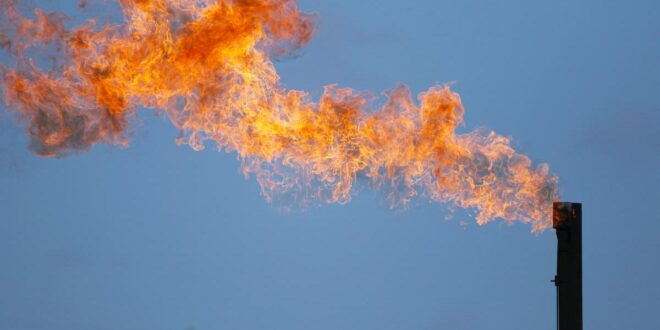Amendments to the EU’s draft methane regulation would allow coal mines to release additional greenhouse gases equivalent to the combined annual CO2 emissions of Belgium and Czechia, according to Ember, a clean energy think-tank.
The analysis, published on Thursday (2 March), shows the latest revisions to the regulation will only cut methane emissions from coal mines by 47%, well below its stated goal of 58%.
“This means an extra 2.2 million tonnes of methane by 2050, which is equivalent to 180 million tonnes of additional CO2-e – more than Belgium and Czechia’s annual CO2 emissions combined,” Ember said.
The EU’s draft methane regulation, tabled in December 2021, aims to bring Europe in line with a global pledge to slash methane emissions by 30% before the end of the decade.
Methane can leak from fossil fuel infrastructure during extraction and transport and has more than 80 times the global warming potential of CO2 in the first twenty years after it reaches the atmosphere.
The EU regulation focuses on methane leaks from the oil and gas industry, as well as from active and abandoned coal mines.
For coal, it envisages a two-step ban on venting and flaring of methane – by 2025 from drainage stations, and by 2027 from ventilation shafts.
However, amendments pushed by EU member states last December have increased the venting thresholds for thermal coal. And EU countries also pushed back the adoption of venting rules for coking coal used in steelmaking for at least another five years after the regulation is adopted – two years later than the EU’s initial proposal.
“Without imposing a venting threshold on coking coal mines, the scope of the regulation to reduce EU coal mine methane emissions is capped at 55%,” Ember estimated.
The European Commission, which had initially put forward a more ambitious proposal on coal mine methane, declined to comment on the ongoing legislative process.
Coal mines – chiefly active ones – are the EU’s single largest source of methane in the energy sector, with Poland alone responsible for two-thirds of related emissions in 2020.
“Underground coal mines emit the most but are the easiest to mitigate,” Ember said. Mitigation is easiest from underground mines, with readily available technologies capable of reducing emissions by up to 70%, the think-tank added, citing figures from the International Energy Agency (IEA).
Overall, Ember reckons that 60-70% of methane emissions from coal mining can be mitigated at a very low cost to operators. Some could even make a profit by reselling the captured methane to gas companies.
“This profitable methane would be enough to generate 0.6 TWh of electricity, similar to the total household electricity consumption in large Polish cities, such as Wroclaw,” Ember estimated.
The vast majority of these mines are located in Poland, with Romania and Czechia coming a distant second and third.
Coking coal in focus
The absence of methane venting rules for coking coal can be explained by its inclusion in a list of 30 raw materials considered “critical” to EU industry.
Coking coal is used in steel production as a reducing agent and a source of energy to melt iron ore. As such, it is essential for sectors such as automotive, railways, defence, and construction but also in green industries like wind turbines.
Polish group JSW is the largest producer of high-quality hard coking coal in the EU and one of the leading producers of coke used for smelting steel.
Jerzy Buzek, a former prime minister of Poland, was among those lobbying to maintain coking coal on the EU’s list of critical raw materials the last time it was updated, in 2020.
“Manufacturing of one wind turbine of 1MW capacity requires around 200 tonnes of coking coal,” said Steel for Europe, a lobby group founded by JSW. As wind energy picks up, so will demand for high-quality steel, the group said back in 2020, calling for the establishment of “a European Coking Coal and Steel Community”.
JSW did not return calls and emails from EURACTIV asking for comment on the methane regulation.
Sabina Assan, the Ember analyst who led the study, said the inclusion of coking coal on the EU list of critical raw materials is “definitely the reason why” it has so far escaped EU rules on methane venting.
“There is an overall understanding that coking coal will not be phased out as quickly as thermal coal because of its use in steelmaking, and lack of immediate alternatives,” Assan told EURACTIV.
And while Ember agrees that venting thresholds for coking coal should be more lenient than for thermal coal, “we do not agree on a lack of rules altogether,” she said.
Furthermore, methane emissions from coking coal are easy to abate, Ember argued.
“Coking coal is more methane intensive than thermal coal, and given that a large part of mitigating the methane is even profitable… there is no real justification not to regulate methane at coking coal mines. It won’t close the industry or destroy profitability,” Assan said.
Besides, methane captured from these operations can be used for electricity generation, Ember said. In Poland, JSW has already received funding for its methane reduction programme, which plans to increase the capture of methane emissions by the drainage system above 50% and use this to produce electricity and heat, Ember pointed out.
According to Assan, “coking coal is a rare example of an ‘easy-to-abate’ sector. She pointed to the United Nation’s Global Methane Assessment, which says coal sector methane “could be possibly halved with mitigation measures largely being implemented at breakeven cost or even at a profit by using the methane.”
For coking coal mines, Ember recommended that the regulation should enforce a venting threshold of a maximum of 5 tonnes of methane per kilotonne of coal from 2027. Such a scenario would put the EU on track to reach its 58% emissions reduction goal, it said.

 Iran Energy News Oil, Gas, Petrochemical and Energy Field Specialized Channel
Iran Energy News Oil, Gas, Petrochemical and Energy Field Specialized Channel



